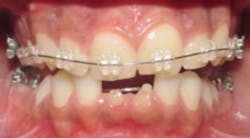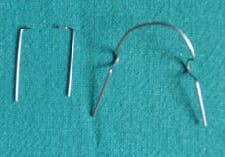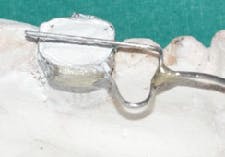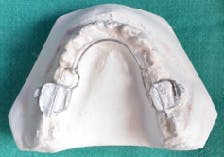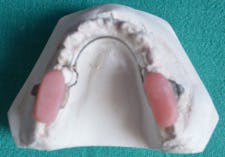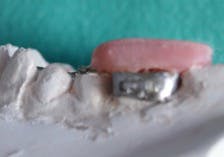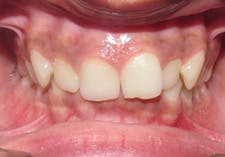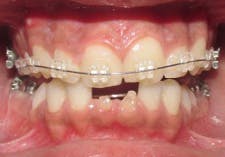8-step fixed bite block procedure without cementation offers multiple advantages
Bite planes can be used in Class I and Class II, Division 1 and Division 2 cases for the correction of a deep bite with moderate overjet. A deep bite must be opened before brackets can be bonded in the mandibular arch. The most common devices used to open the bite are removable anterior or posterior bite planes and glass ionomer cement (GIC).
A removable posterior bite plane is temporary, can be lost or broken, and sometimes may even be swallowed by patients. GIC bite blocks can cause discomfort during chewing due to the single points of contact on each side. Many of these problems can be overcome, however, by using a fixed bite plane without cementation, which is then easy to remove after correction.
Fixed bite block procedure
1. Place the band on teeth Nos. 19 and 30, and take an alginate impression. Keep in mind that in the impression, the band is placed in the proper position.
2. Pour the impression in plaster of paris, and then remove the cast after the plaster of paris sets.
3. Bend the lingual arch (0.9 mm) wire and adapt it lingually in the mandible (figure 1).
4. For the occlusal component, adapt the wire (0.7 mm) to the occlusal surface. Start from the middle of the second molar and move up mesially to the interdental space between the first and second premolar. Then, give a vertical bend downward to adapt between the embrasure area and the end resting on the lingual arch (figure 1).
5. Solder the lingual arch onto the band and the occlusal component onto the lingual arch (figures 2a and 2b).
6. Apply separating media on the occlusal surface of the posterior teeth, and form an acrylic bite block on the occlusal component (figures 3a and 3b).
7. Remove it from the cast and cement the band onto the respective teeth (figures 4a and 4b).
8. After the desired correction is achieved, cut the occlusal component near the solder point with the help of a cutter, and remove the block.
Advantages
This fixed bite plan technique offers several advantages:
- It does not need patient cooperation.
- It can be used full time.
- It does not require any bonding material, so there is no damage to enamel.
- It is hygienic.
- It can be easily removed.
To read more articles about clinical dentistry, visit DentistryIQ.com/clinical.
Amit Sidana, BDS, MDS; Pooja Tiwari, BDS; and Ragni Tandon, BDS, MDS, are dentists in India. Dr. Sidana, an orthodontist, is a senior lecturer at Maharaja Ganga Singh Dental College in Rajasthan, India. Dr. Tandon is a professor and head of the Department of Orthodontics at Saraswati Dental College in Lucknow, Uttar Pradesh, India. You may contact Dr. Sidana directly by e-mail at [email protected].
